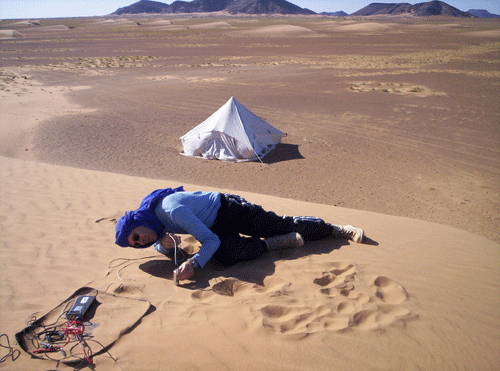Flows of Granular Solids and Gases
Our work focuses on fundamental studies of granular and
gas-solid flows with geophysical and industrial applications. We
perform laboratory and field experiments, create numerical simulations,
model fluid mechanics and heat transfer in these flows, and develop new
instrumentation. Recently, we conducted microgravity experiments and developed theories on capillarity,
including unsaturated porous media, contact angle prediction with or
without electrowetting, and imbibition of liquids into perforated
plates. Click on banners to the left to explore this work.
Industrial applications in bulk solids
Our group has developed unique capacitance instrumentation for
ultra-precise inline measurements of the bulk density of powders and
grains, locally and in real time, as well as their moisture and/or
solvent content. The probes are used in industries handling bulk solids, and also in geophysical applications such as swow avalanches and planetary deserts.To explore how your industry could benefit from such measurements, contact Michel Louge at MYL3@cornell.edu
Research summary
Our research has
contributed to subjects as diverse as the scale-up of circulating
fluidized beds under atmospheric and pressurized conditions; the
behavior of pressurized
cyclone separators; the interactions of gas and
solid particles in pneumatic
transport of particles; the impact of
small solid spheres; the heat
transfer in suspensions of gases and
agitated solids; flows of
grains on inclines; segregation
and flow of
grains in microgravity; mechanisms of particle interactions in
confined
agitated granular media; the water
budget, dust inoculation, and
seepage through desert sand dunes; "eruption
currents," which include powder snow avalanches; and unsaturated
porous media.
We have also developed capacitance instrumentation
that records
solid concentration, velocity and water content in snow avalanches,
fluidized
suspensions, sand dunes
and alpine snow packs.
Applications of this research are found in Chemical Engineering
(e.g., catalytic cracking, solids transport, solid combustion) and
Geophysics (e.g., snow avalanches, desertification). Our experimental
facilities have included a circulating
fluidized bed, a large inclined
chute, a flume,
and a unique setup to record restitution
and friction
in the impacts of small spheres.
We conducted field experiments on NASA's microgravity airplane and on the International Space Station, at the ZARM free-fall tower in Bremen, in the Sahara and Qatar desert, and in mountains.
Michel Louge measures the density of sand at the surface of a barchan sand dune near Akjoujt in Mauritania.
Collaborators and Sponsors
We have had active collaborations with the Universite de Rennes, the University of Nottingham, the Universite de Nantes, the Weill-Cornell Medical College in Qatar, and the Ecole Polytechnique Federale de Lausanne. Sponsors have included the NSF, the US DoE, NASA, ARO, Electricite de France, the International Fine Particle Research Institute, the ACS Petroleum Research Fund and the Qatar National Research Foundation.
Miscellaneous research activities
We developed and published a new statistical mechanics framework for predicting the behavior of unsaturated porous media from known geometry and surface energy. The article is open-access with Phys. Rev. E. We published another article
predicting the regimes of behavior of the advancing and receding
contact angle using elements of statistical mechanics. Here is a presentation at Interpore 2017 summarizing these results. More recently, we extended our ab initio predictions of the contact angle to electrowetting.
Hardware for our experiment on Inertial Spreading and Imbibition of
a Liquid Drop through a Porous Surface (ISPS) launched aboard the S.S. Alan Bean NG-12 spacecraft from Wallops Island on November 2, 2019, and berthed on the International Space Station on November 4. On December 10, ISS Commander Luca Parmitano successfully set up ISPS hardware in the Microgravity Science Glovebox
of the International Space Station. He carried out imbibition tests
with water spheres on December 11. Details are found in our page on Unsaturated Porous Media. This Cornell Chronicle article provides context.

